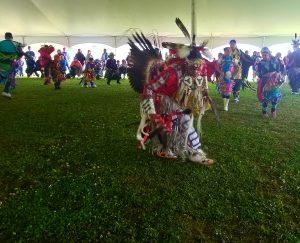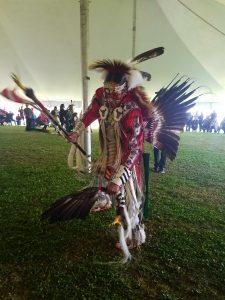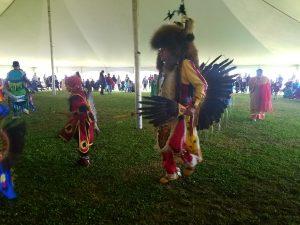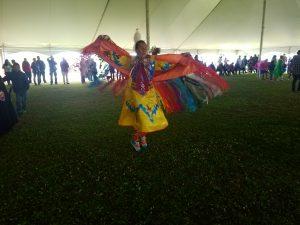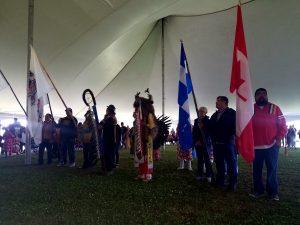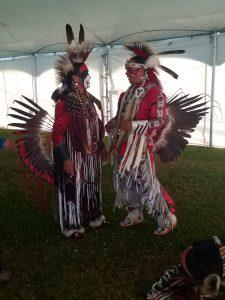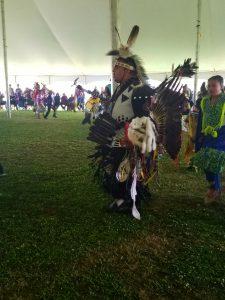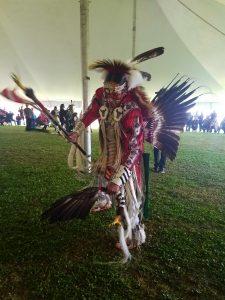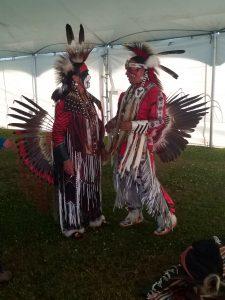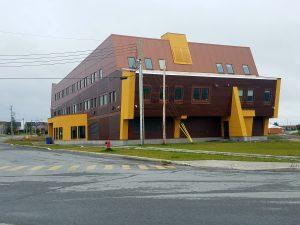“Under the reflection of the northern lights, we see the head of Ciiwetinustikwaan, the man of the north.” – saying of the Northern Cree
After days of adventure travel in the Saguenay-Lac-St Jean area come to a close, I let my fingers meander across the map to find my next would-be destination. This is actually one my of favorite activities: simply pick a remote location on a map and make my way there, never really knowing what I’ll find. I trace my fingers along Highway 167 deep into the interior of Quebec north until the road ends – in the reservation of the northern Cree Nation, located in Mistissini, about seven hours north of Quebec City. “What’s there, I wonder?” I have no idea, which is reason enough to go!
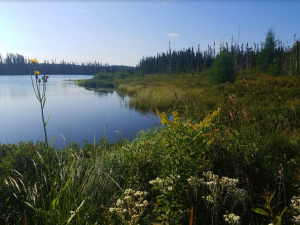
Lakes and spruce trees. Typical view of central/northern Quebec province.
Check your Misconceptions at the Door
The long drive gives me plenty of time to guess at what I might find. I wonder if I will come across a fairly impoverished town, lined with dilapidated shacks and run-down houses, rusted hulls of cars and perhaps a random stray dog roaming the street? After all, I’ve come across similar scenes on occasion when visiting indigenous communities in the southwestern US and Latin America. And with a town so remote from anything else, should I expect the same?
After several hours of driving, the highway abruptly ends and I find myself on the outskirts of town. Boy, was I wrong. The large, modern-looking homes look like they’ve been constructed within the past decade. Driveways are replete with nice looking cars, motorboats and snowmobiles. “Welcome to Cree Nation,” the sign on the outskirts of town greets me in English, French and in Cree syllabic writing. Wait, the Cree have their own written language?? Wow. I must confess, I’m rather surprised. “So this is where the road ends,” I think.
-
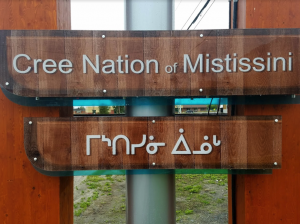
- The Cree written language
The Story of Mistissini
The reservation of the northern Cree is in central Quebec province, on the very location of their ancestral hunting grounds. Like so many other First Nations, the Cree believe that animals and humans were put on earth to help each other. Families traditionally had hunting territories, controlled by a respected hunter, the Amiskw Uchimauu, also known as the tallyman. “This is a land of stories and legends, where traditional knowledge about the land is expressed in names given to places. The landscape holds the memory of generations of individuals who developed an extraordinary knowledge,” reads the sign outside a local shop.
The name Mistissini means “the big rock” and refers to a large boulder found on the west bank of vast Lake Mistissini, the largest fresh water lake in Quebec. Mistissini rock marks a traditional passage point and meeting place for the Cree. Legend claims that a spirit inhabits it and passersby always leave tobacco as a gift. However, they never point directly at the rock, lest they cause the easily offended spirit to unleash a ferocious storm on the lake.
In the 17th century, the region became a central trading location for French trappers, missionaries and natives. The modern community of Mistissini was established in the 1930s by the Hudson Bay Company. Over the years, the community grew to include several Cree groups and the town today numbers roughly 4,000 inhabitants. Mistissini’s economy is sustained through exploitation of the abundant natural resources nearby. Most people here are employed in the lumber or mining industries. In fact, job opportunities have been so good here that Cree from surrounding areas have been steadily moving in. One gentleman told me that he moved back all the way from Nova Scotia, where the only employment he could find was at McDonald’s. Here in Mistissini, he is the proud manager of the local hotel. He is not the only one to find success, it seems. The town has tripled in the past two decades, which would also explain the many modern buildings and homes I noticed.
Pow Wow of the Cree Nation
As it happens, this day is also the annual pow wow of the Cree nation. Who knew! Driving all the way out here was a gamble, but it sure paid off for me today. The weather is overcast and rainy, but that doesn’t dampen anyone’s spirits here. Dancers in full tribal regalia make their way to the large, white tent in the center of town. The hypnotizing rhythm of the drums, accompanied by throaty vocalizations from exclusively male singers sets the overall mood. The atmosphere is festive and the event master cracks one joke after another over the mic.
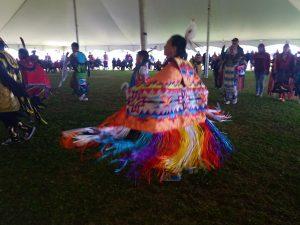 Although the prayer invocation is held in the Cree language, the rest of the pow wow is conducted almost exclusively in English. Only occasionally do speakers temporarily switch to Cree. In fact, English seems to be the preferred language anywhere I go in town. Kids on the street hurl the same English-language insults and taunts at each other as kids in my neighborhood back in California. Anywhere I go, it seems that English is the only language spoken. I don’t hear a single word of French, which strikes me as odd, given that Quebec is a Francophone province. Intrigued and puzzled, I ask one of the locals about it. He informs me that out on the street, English is the primary language while Cree is spoken predominantly inside the home. French may be taught at school but is not widely spoken within the Cree reservation – a legacy of centuries of fighting between the Cree and the French colonists, he claims.
Although the prayer invocation is held in the Cree language, the rest of the pow wow is conducted almost exclusively in English. Only occasionally do speakers temporarily switch to Cree. In fact, English seems to be the preferred language anywhere I go in town. Kids on the street hurl the same English-language insults and taunts at each other as kids in my neighborhood back in California. Anywhere I go, it seems that English is the only language spoken. I don’t hear a single word of French, which strikes me as odd, given that Quebec is a Francophone province. Intrigued and puzzled, I ask one of the locals about it. He informs me that out on the street, English is the primary language while Cree is spoken predominantly inside the home. French may be taught at school but is not widely spoken within the Cree reservation – a legacy of centuries of fighting between the Cree and the French colonists, he claims.
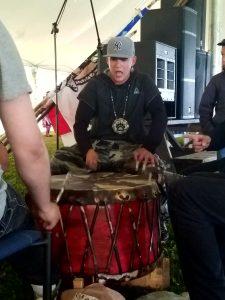 The pow wow itself opens with the grass dance. A lone dancer takes the circle, moving in an almost trance-like state. This dance, which emphasizes symmetry and long, winding motions, signifies the blessing of the dancing ground. Following this, the grand entrance presents all additional dancers. At the head of the procession, flag bearers carry the colors of the Cree Nation as well as those of Quebec and Canada. Men, women and children show off their colorful regalia. Each of these elaborate designs signify or represent a certain aspect of Cree culture and dancers can spend almost the entire year designing them. Unfortunately, I do not know much about the nature or symbolisms behind the dances and songs. A Cree lady looks amused at me. “Interesting?” “Oh hell yeah. I wish I knew more about what was going on here,” I respond. She smiles and proceeds to give me a quick rundown of the various symbolisms at play. The red regalia on one warrior signifies the color of the protector. Another dancer, covered in feathers, symbolizes a wild turkey. She points out that his style of dance actually mimics the movements of the bird as it forages on the ground. Fascinating!
The pow wow itself opens with the grass dance. A lone dancer takes the circle, moving in an almost trance-like state. This dance, which emphasizes symmetry and long, winding motions, signifies the blessing of the dancing ground. Following this, the grand entrance presents all additional dancers. At the head of the procession, flag bearers carry the colors of the Cree Nation as well as those of Quebec and Canada. Men, women and children show off their colorful regalia. Each of these elaborate designs signify or represent a certain aspect of Cree culture and dancers can spend almost the entire year designing them. Unfortunately, I do not know much about the nature or symbolisms behind the dances and songs. A Cree lady looks amused at me. “Interesting?” “Oh hell yeah. I wish I knew more about what was going on here,” I respond. She smiles and proceeds to give me a quick rundown of the various symbolisms at play. The red regalia on one warrior signifies the color of the protector. Another dancer, covered in feathers, symbolizes a wild turkey. She points out that his style of dance actually mimics the movements of the bird as it forages on the ground. Fascinating!
I could stand here for hours, just studying the various dance styles and rhythmic drums. And I do. Eventually, hunger overcomes me and I go to sample the local foods – fry bread, Indian pogo and a moose burger. Yes, real moose meat in a burger. Delicious!
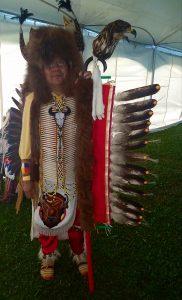
The Road Less Traveled
Robert Frost famously wrote of the young man who “took the road less traveled by. And that has made all the difference.” I’ve internalized this guidance on many random sightseeing occasions throughout my travels. Sometimes, I find only mundane towns or disheveled, soulless roads. Other times, I’ve encountered unexpected beauty, such as ancient villages in Romania or the Cree Nation pow wow in northern Quebec. I’m never really looking for anything specific, but rather keep my mind open to anything that may come my way. No matter what though, it’s the tantalizing unpredictability, the ‘what if’ that inspires me to keep searching for more. Here’s to eternal searching – may we never cease to seek, and always find that which we least expect.
